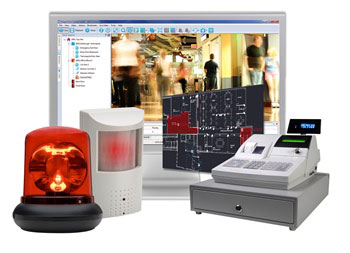
How integrations help operators to deliver their security objectives
What objectives would I like to achieve with a new surveillance system?
Where are the most high-risk areas of my site?
How will my team receive the information they need in real-time?
These questions are key for security managers when they plan for a new surveillance system, to ensure they make informed decisions about their operational requirements. Otherwise, projects can all too easily get out of hand in terms of cost or scope.
It’s at the planning stage when third party functionality should be considered. Integrations should only be chosen if they will support security operators’ daily tasks, and not just for show. In this blog, we take a look at how 3 types of integrations help operators to deliver their security objectives; a topic we will be exploring further in our upcoming Accredited CPD Training Webinar.
Secure multiple sites with integrated intruder panels
For those in charge of security at multiple sites, such as a school district, it’s incredibly important that staff can easily manage the alarm systems which must be set each evening once everybody has left the premises.
This can be made much easier for operators to manage by using a module which allows alarms and events to integrate with your video management system. You get complete video and alarm management in a single user interface, which supports operators to respond much more quickly to incidents that arise. In the example of the school district, this integration module allows the operator on duty to receive alerts based on motion detected at any of the sites they are monitoring, so they can immediately notify emergency responders in real time if a breach has been identified.
The complexity of this type of integration module comes from the system architecture you choose. A centralized set-up means you have one integration that controls all of your schools’ alarm systems; a distributed architecture means you have an integration module for each site. Using the distributed model, if one integration module crashes, only one school would lose its alarms, leaving the rest of the sites unaffected. But this is a more expensive option to deploy.
Both types of system architecture have benefits depending on your use case. To learn more about the different types of system architecture and how to incorporate integrations, you can attend and ask questions at the upcoming Accredited CPD Webinar “Video Management Systems: Adding Value with Integrations”
Access control for high-security sites
When you think about moving through an airport, there are many doors which are clearly locked. These might be, for example, entry points to the runway which staff members need to pass through but could be dangerous for the public. Due to the safety aspect, airport security teams need to be made aware immediately if a secure door is left open.
There are a range of integration modules which can push this information to the operator’s Video Management Software (VMS) in the form of an alert. As soon as an unlocked door has been recognized in the system, the operator receives an alarm and is able to view video footage of the door in real time. This allows the operator to immediately see if there has been a breach or whether the door is authorized to be open, and then if necessary deploy a security guard to secure the door.
Thanks to the seamless communication between the integration module and the security system, this can help your security team to secure entry points before anyone else in the airport has noticed.
Assistant points to ensure public safety
On large sites such as universities, it’s vital that the security team can ensure the safety of staff and students, wherever they might be on campus. For many city-based universities, this can mean you are covering a wide geographical area. The security team needs to be ready for a huge range of incidents that might occur, such as attacks at night which threaten people’s safety.
In this application, an integration module can be applied which connects video intercom assistant points with your video management system. These assistant points enable 2-way video communication at the push of a button, between a staff member who would like a virtual escort across a dark part of campus, and the operator in the control room. This can be developed further by integrating the Pan-Tilt-Zoom (PTZ) Cameras in your network, which help operators to get a better view of the situation and provide support and a greater feeling of safety to the individual who has requested assistance.
When security teams have limited resources, this type of integration is a great way to focus human resources on real-time situations in the areas where it counts.
To learn more about how third party integrations can help support your operators to manage their daily work processes, you can sign-up below to attend our upcoming online Accredited CPD Training: “Video Management Systems: Adding Value with Integrations”.








